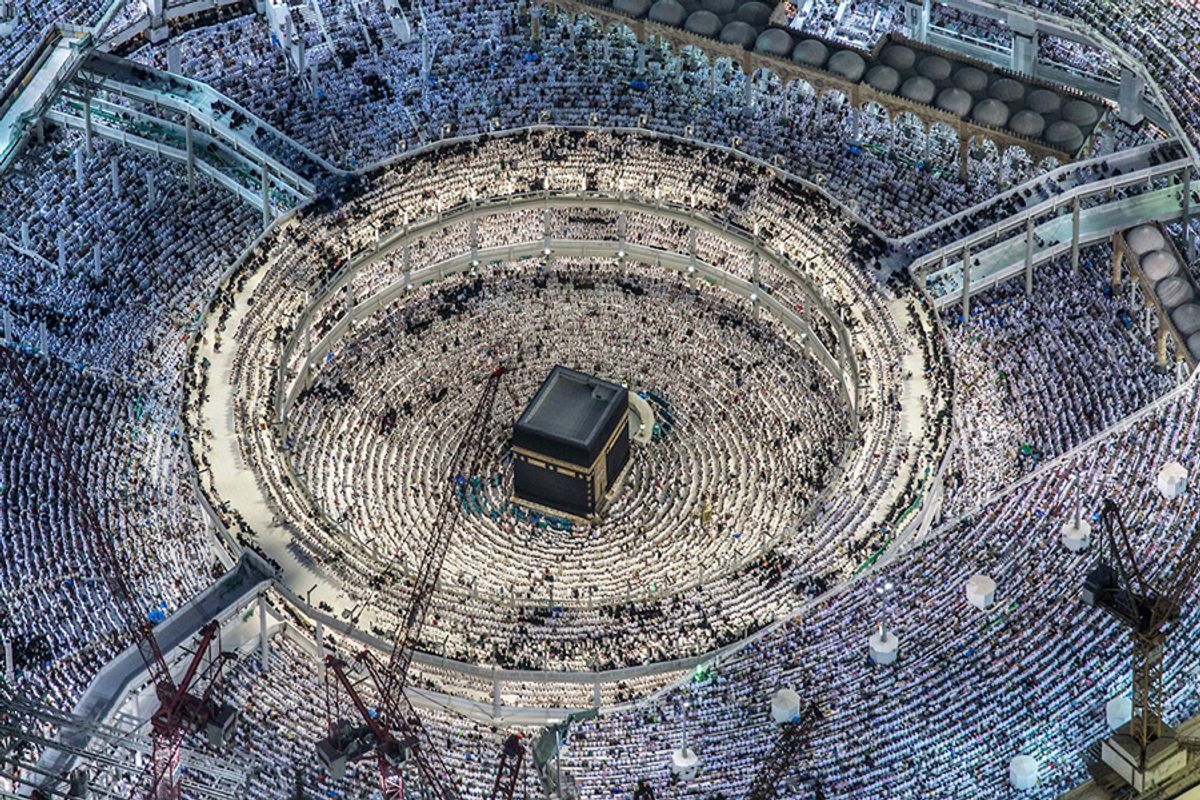In the 1970s, around 100,000-200,000 people made the annual hajj pilgrimage to Mecca, Islam’s holiest city, each year; now, that figure is around three million. The work of the Saudi artist Ahmed Mater, the subject of a solo show, Mecca Journeys (until 17 June), at the Brooklyn Museum, gives fascinating glimpses into the flood of pilgrims, dizzying building boom, influx of wealth and the lives of construction workers in the Saudi Arabian city. It includes large-scale photographs from Mater’s series Desert of Pharan: Unofficial Histories Behind the Mass Expansion of Mecca, video works and installations. Especially compelling is the two-channel video Leaves Fall in All Seasons (2013), with juxtaposes the massive detached golden top of the Makkah Royal Hotel Clock Tower, clung to by a construction worker, calmly soaring up by a wire during construction—a strange ascension, given its crescent-moon pinnacle—with a spinning shot of the crowd below.
Place is also important in the work of the French-Moroccan artist Yto Barrada, who has her first New York solo exhibition, How to Do Nothing with Nobody All Alone by Yourself (until 5 May) at Pace Gallery. The exhibition is a panoptic survey that unfolds across three floors and three branches of the gallery’s East 57th street location (Pace, Pace/MacGill and Pace African and Oceanic Art). Touching on themes of dislocation, education and abstraction, and working seamlessly across photography, sculpture, video and textiles, the New York-based artist’s versatile practice merits the sweep of space and breadth of attention. Of special interest is, for example, a series of textiles that revisit Frank Stella’s classic fluorescent abstractions, but are also influenced by Moroccan cities and the founders of the Casablanca School, the painters Mohamed Chebaa, Farid Belkahia and Mohammed Melehi, pioneers of Morocccan Modernism. The 2017 stop-animation film Tree Identification for Beginners, meanwhile, recalls Barrada’s mother’s 1966 trip from Morocco to the US on a propagandist travel programme sponsored by the US State Department.
Landscapes both real and imagined are presented in the Metropolitan Museum of Art’s show Thomas Cole’s Journey: Atlantic Crossings (until 13 May), a chronologically organised show that spans the career of the painter, a co-founder of the Hudson River School. It commemorates the bicentennial of his arrival in the US from England and explores how his travels, including trips around Italy from 1831 to 1832, influenced his work. Alongside Cole’s paintings, works by artists that inspired him, from J.M.W. Turner—whose Snow Storm: Hannibal and His Army Crossing the Alps (1812) has been lent by the Tate—to Claude Lorrain. Cole’s magnificent series of five large-scale paintings, The Course of Empire (1833-36), which shows the rise and decline of an imaginary city, recalls Lorrain’s imaginary cityscapes, while his lush pictures of the American wilderness display his proto-preservationist legacy. The show has serious scholarly chops, but could stand on a purely aesthetic level, appreciated for the beauty and splendour of the works.


